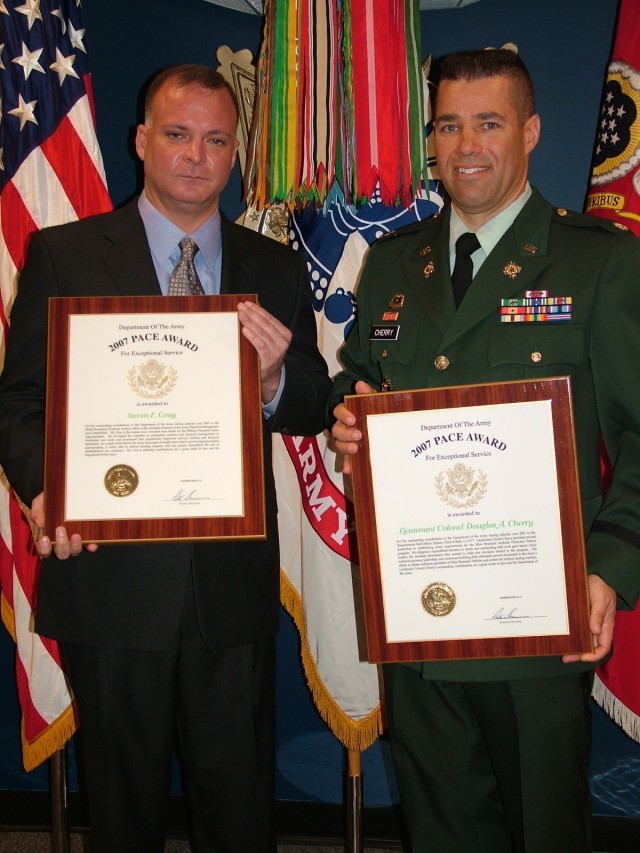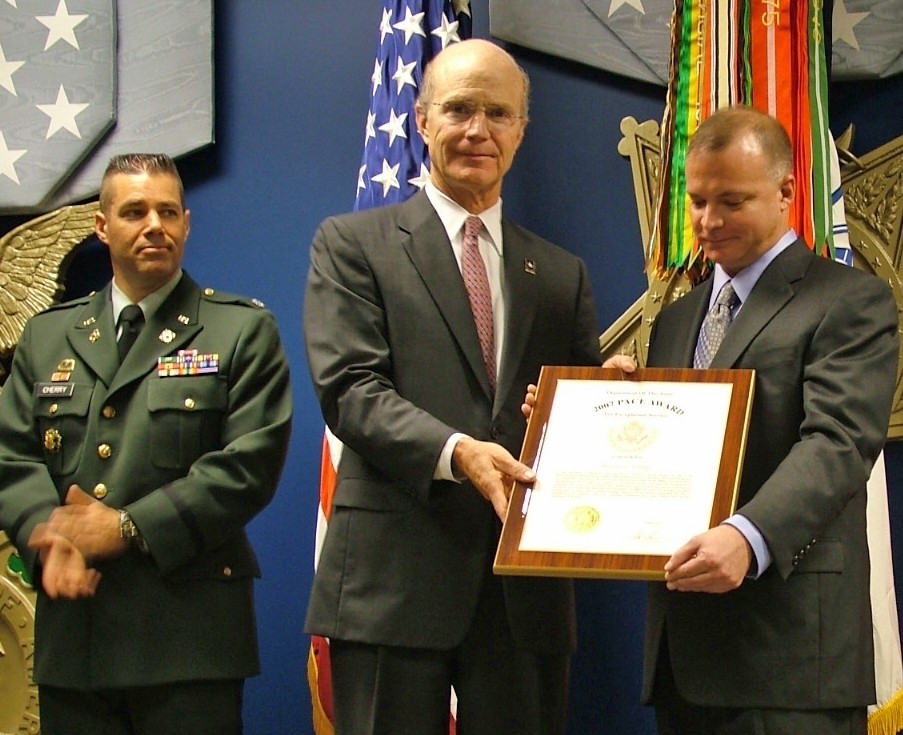WASHINGTON (Army News Service, Sept. 29, 2008) - An Army logistics officer lauded for helping save Soldiers' lives in Afghanistan and Iraq because of better armor protection, and a civilian budget analyst who, in 2007, was in charge of the largest peacetime appropriation in the Department of the Army, were honored by Secretary of the Army Pete Geren Monday.
A capacity crowd filled seats at the Pentagon's Hall of Heroes as Geren presented the Department of the Army Pace Award to Lt. Col. Douglas Cherry and Steven Gray for their respective contributions to the Army.
Cherry was a staff officer for the Army's Office of the Deputy Chief of Staff, G3/5/7. Gray served as a financial analyst in the Office of the Assistant Secretary of the Army, Financial Management and Comptroller.
Cherry was in charge of establishing Army requirements for what's now known as the Mine-Resistant Ambush-Protected Vehicle program, MRAP.
Gray managed a $45-billion budget, which provided the funds needed by the Army to sustain the all-volunteer force, Geren said.
"They epitomize the quality of our Army," Geren told attendees. "And we thank you for many, many years of service," he told the awardees.
Gray said determining how the $45-billion budget was spent for pay and entitlements for active-duty Soldiers was a very stressful job. There's much oversight, "and I had to give numerous briefings to personnel within the Office of the Secretary of Defense and to Congress.
"I had to tell them whether we're on track for spending or that we need additional funds," Gray added.
"Because of the 'Grow-the-Army' campaign, the force structure changed, and costs went up," Gray continued.
But money and balancing the books is his forte, he said. "I started [dealing with money] almost 18 years ago as an enlisted Soldier," said Gray, who was an accounting specialist in Frankfurt, Germany. After three and a half years on active duty, he got out of the service on a Friday and entered Civil Service on a Monday, he said.
He's spent two and a half years at his current job. Previously, he served as a division chief and budget officer at U.S. European Command in Stuttgart, Germany.
Cherry was assigned to the Army staff in 2006 and was responsible for determining Soldiers' and commanders' requirements for tactical wheeled vehicles, Geren said. Those included the up-armored Humvee and what became the MRAP program.
As G-3 lead action officer for the MRAP program, he's [partly] responsible for saving many Soldiers' lives, Geren said. "Soldiers all over the theaters tell us stories of their survival because of the improved vehicles."
In August 2006, former Vice Chief of Staff of the Army Gen. Richard Cody said the Army had a need that the up-armored Humvee couldn't satisfy, Cherry said.
The task to fill that need fell to Cherry.
"Because I worked on the up-armored Humvee program, I was the best person to work on a new program," Cherry said. "We didn't know it would be called MRAP.
"Early on, I met with a group of representatives from various agencies in Crystal City, Va., [across Interstate 395 from the Pentagon]," Cherry recalled. "There were representatives from G-8, from the Program Executive Office, Training and Doctrine Command, and others. They helped us determine what was in the realm of possibilities for the new vehicle."
In the end, however, Cherry was the person responsible for "pulling it all together."
Though he's been on active duty since 1996 and spent 13 years in the Army Reserve, Cherry said he's never deployed to Iraq or Afghanistan; he was able to determine what commanders in the field needed based on conversations with Soldiers who had been downrange, and by reading virtually every report that came into his office about the dangers Soldiers faced and what they needed in the way of protection, among them reports from the Center for Army Lessons Learned at Fort Leavenworth, Kan.
By the end of October 2006, the first MRAP contracts were awarded, Cherry said. Today, some 10,000 MRAPs are in the combat theaters.
Gray continues to work in the same Pentagon office where he worked in 2007. Cherry now works in the Office of the Chief of Army Reserve, Force Integration Sustainment Branch.
"I'm looking at future Army units and how they'll meet future threats," he said. Because Cherry is a logistics officer, his focus is largely on quartermaster, ordnance and personnel-service-support units.
"The Army has more requirements than it has resources, so I provide recommendations to commanders [on what may need to be added to the mix and what they might best be able to eliminate or modify] to help them balance risks," Cherry said.
The Pace award is named after former Secretary of the Army Frank Pace Jr., who held the office from 1950 to 1953. The award has been presented to an Army officer in the rank of lieutenant colonel or below, and a civilian employee in grade GS-14 equivalent or below every year since it was established in 1962, officials said.
Awardees are selected based on their performance and completion of significant staff assignments that benefit the Army by providing financial savings or help develop technological improvements for the field.




Social Sharing